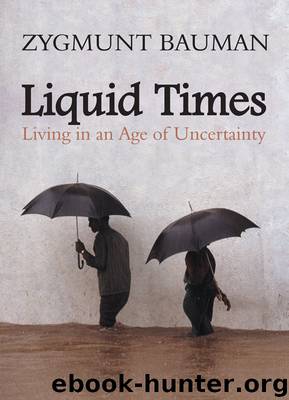Liquid Times by Zygmunt Bauman

Author:Zygmunt Bauman
Language: eng
Format: epub
Publisher: Wiley
4
* * *
Out of Touch Together
Inhabited areas are described as ‘urban’ and called ‘cities’ if they are marked by a relatively high density of population, interaction and communication. Today, they also happen to be the places where socially conceived and incubated insecurities are confronted in a highly condensed and so particularly tangible form. It is also in the places called ‘urban’ that the high density of human interaction has coincided with the tendency of fear born of insecurity to seek and find outlets and objects on which to unload itself – though this tendency has not always been the distinctive characteristic of these places.
As Nan Ellin, one of the most acute researchers and insightful analysts of contemporary urban trends, points out, protection from danger was ‘a principal incentive for building cities whose borders were often defined by vast walls or fences, from the ancient villages of Mesopotamia to medieval cities to Native American settlements’.1 The walls, moats and stockades marked the boundary between ‘us’ and ‘them’, order and wilderness, peace and warfare: enemies were those left on the other side of the fence and not allowed to cross it. ‘From being a relatively safe place’, however, the city has become associated, mostly in the last hundred years or so, ‘more with danger than with safety’.
Today, in a curious reversal of their historical role and in defiance of the original intentions of city builders and the expectations of city dwellers, our cities are swiftly turning from shelters against danger into danger’s principal source. Diken and Laustsen go so far as to suggest that the millennia-old ‘link between civilization and barbarism is reversed. City life turns into a state of nature characterised by the rule of terror, accompanied by omnipresent fear.’2
We can say that the sources of danger have now moved almost wholly into urban areas and settled there. Friends – but also enemies, and above all the elusive and mysterious strangers who veer threateningly between the two extremes – now mix and rub shoulders on the city streets. The war against insecurity, and particularly against dangers and risks to personal safety, is now waged inside the city, and inside the city battlefields are set aside and front lines are drawn. Heavily armed trenches (impassable approaches) and bunkers (fortified and closely guarded buildings or complexes) aimed at separating, keeping away and barring the entry of strangers, are fast becoming one of the most visible aspects of contemporary cities – though they take many forms, and though their designers try hard to blend their creations into the cityscape, thereby ‘normalizing’ the state of emergency in which urban residents, addicted to safety yet perpetually unsure of it, dwell daily.
‘The more we detach from our immediate surroundings, the more we rely on surveillance of that environment . . . Homes in many urban areas around the world now exist to protect their inhabitants, not to integrate people with their communities,’ observe Gumpert and Drucker.3 Separation and keeping a distance becomes the most common strategy these days in the urban struggle for survival.
Download
This site does not store any files on its server. We only index and link to content provided by other sites. Please contact the content providers to delete copyright contents if any and email us, we'll remove relevant links or contents immediately.
The Secret History by Donna Tartt(16605)
The Social Justice Warrior Handbook by Lisa De Pasquale(11484)
Thirteen Reasons Why by Jay Asher(7777)
This Is How You Lose Her by Junot Diaz(5747)
Weapons of Math Destruction by Cathy O'Neil(5027)
Zero to One by Peter Thiel(4814)
The Myth of the Strong Leader by Archie Brown(4783)
Promise Me, Dad by Joe Biden(4439)
Stone's Rules by Roger Stone(4409)
Beartown by Fredrik Backman(4398)
How Democracies Die by Steven Levitsky & Daniel Ziblatt(4391)
The Fire Next Time by James Baldwin(4336)
100 Deadly Skills by Clint Emerson(4069)
A Higher Loyalty: Truth, Lies, and Leadership by James Comey(4024)
Rise and Kill First by Ronen Bergman(4006)
The David Icke Guide to the Global Conspiracy (and how to end it) by David Icke(3874)
The Farm by Tom Rob Smith(3868)
Secrecy World by Jake Bernstein(3773)
The Doomsday Machine by Daniel Ellsberg(3725)
